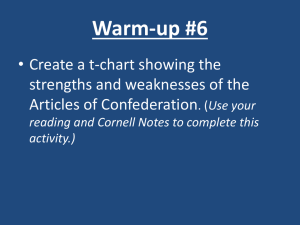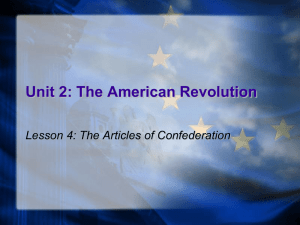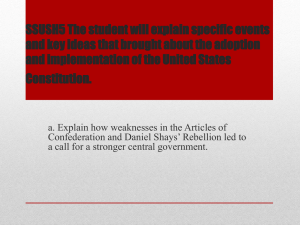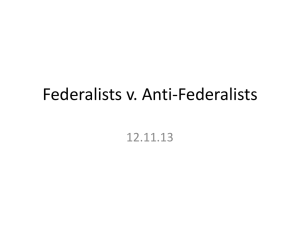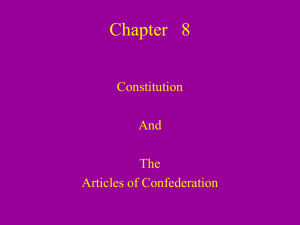Writing the Constitution Source Packet
advertisement
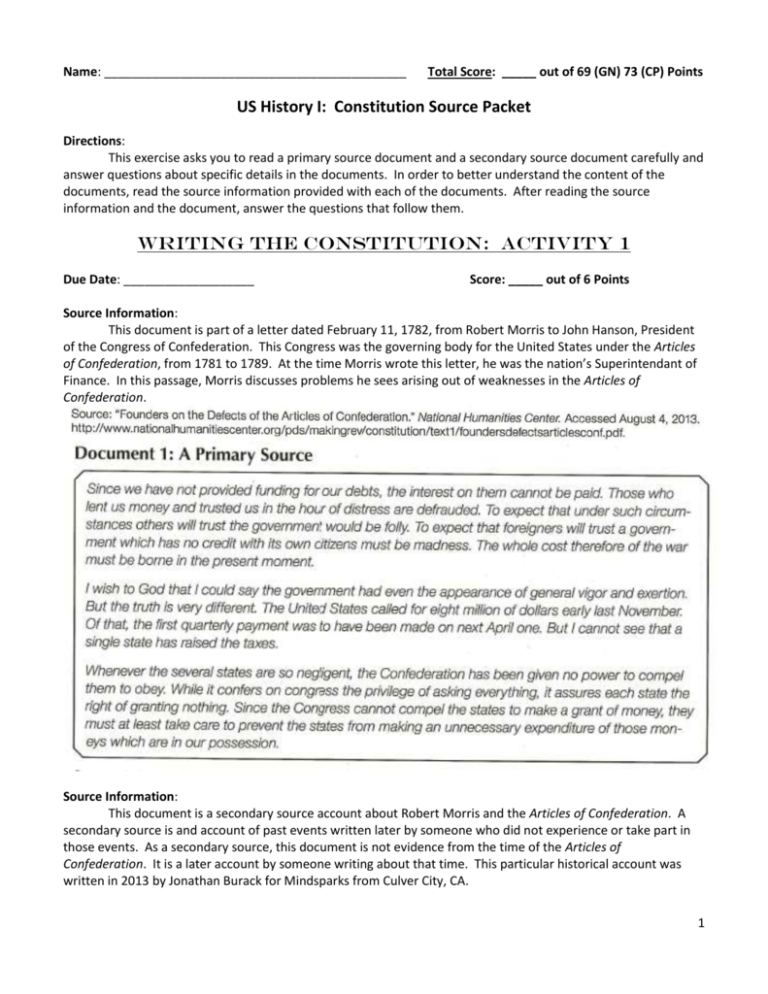
Name: ____________________________________________ Total Score: _____ out of 69 (GN) 73 (CP) Points US History I: Constitution Source Packet Directions: This exercise asks you to read a primary source document and a secondary source document carefully and answer questions about specific details in the documents. In order to better understand the content of the documents, read the source information provided with each of the documents. After reading the source information and the document, answer the questions that follow them. Writing the Constitution: Activity 1 Due Date: ___________________ Score: _____ out of 6 Points Source Information: This document is part of a letter dated February 11, 1782, from Robert Morris to John Hanson, President of the Congress of Confederation. This Congress was the governing body for the United States under the Articles of Confederation, from 1781 to 1789. At the time Morris wrote this letter, he was the nation’s Superintendant of Finance. In this passage, Morris discusses problems he sees arising out of weaknesses in the Articles of Confederation. Source Information: This document is a secondary source account about Robert Morris and the Articles of Confederation. A secondary source is and account of past events written later by someone who did not experience or take part in those events. As a secondary source, this document is not evidence from the time of the Articles of Confederation. It is a later account by someone writing about that time. This particular historical account was written in 2013 by Jonathan Burack for Mindsparks from Culver City, CA. 1 Assessment Questions: 1) After reading the sources it is evident that the Articles of Confederation had its strengths and weaknesses. Provide and explain at least two strengths and two weaknesses mentioned in the source material provided. (4 points) 2) What details in Document 2 help you to better understand why Morris is as upset as he is about the Articles of Confederation? (2 points) 2 Writing the Constitution: Activity 2 Due Date: ___________________ Score: _____ out of 10 (GN) 14 (CP) Points Source Information: In 1786, Revolutionary War soldier Daniel Shays led an uprising of angry and indebted farmers in Massachusetts. The rebellion’s high point was a bloody clash with General William Shepard’s Massachussetts state militia at the U.S. Arsenal in Springfield on January 25, 1787. Captain Park Holland fought against Shays. He was with Benjamin Lincoln’s forces and was not in Springfield on January 25. Here he states what he learned of the battle at the time. This passage is adapted from part of a longer account Holland wrote in 1834. 3 Assessment Questions: 1) Briefly explain the following: When and where did Holland first learn what Shays was trying to do? When and where did he learn of General Shepard’s fight with Shays’ forces? What did he learn about this fight before he arrived in Springfield? (6 points) 2) What important details about the battle did he learn from General Shepard’s account? (4 points) 3) (CP Only) What gives you confidence that this account is reliable, and is there anything about it that leads you to question its reliability? (4 points) 4 Writing the Constitution: Activity 3 Due Date: ___________________ Score: _____ out of 9 Points Source Information: In the years leading up to Shay’s Rebellion, Massachusetts passed higher poll and real estate taxes to pay off the state’s war debt. The taxes had to be paid in gold and silver, rather than goods, produce, or paper currency. The slow economy and a shortage of gold and silver currency made this difficult. Creditors desperately tried to collect on all private debts, leading to thousands of lawsuits. A petition from the town of Athol to the Legislature in May, 1786, begged the legislature to provide relief. This document was adapted from part of that petition. Assessment Questions: 1) Notice the underlined phrases in this document. Some of them may be confusing. With a partner, list the meanings of these phrases as they are used in the document. (5 points) 2) Based on this document alone, do the petitioners seem to be very wealthy, very poor, or individuals of moderate means? Explain your answer using evidence from the document. (4 points) 5 Writing the Constitution: Activity 4 Due Date: ___________________ Score: _____ out of 6 Points Source Information: In the 1780’s, the Massachusetts legislature passed higher taxes to pay off the state’s Revolutionary War debt. At the time, a poor economy was hitting indebted farmers hard. Creditors who loaned them money were suing thousands of them. Courts were selling off the farmers’ lands to pay their debts. In 1786, Revolutionary War soldier Daniel Shays led an uprising of angry farmers seeking to shut down those courts. Fears of anarchy led to calls for a much stronger federal government. Thomas Jefferson responded to Shays’ Rebellion in a different way. This document is adapted from part of a January 30, 1787 letter Jefferson wrote from Paris, France to James Maddison. 6 Assessment Questions: 1) Jefferson’s central idea is this passage deals with the idea of rebellion. At one point, he says, “a little rebellion now and then is a good thing.” Based on details in the letter, explain why he thinks rebellion may be a good thing. (4 points) 2) How does this central idea about rebellion help explain Jefferson’s attitude about Shays’ Rebellion, specifically, as expressed in the first paragraph? (2 points) 7 Writing the Constitution: Activity 5 Due Date: ___________________ Score: _____ out of 8 Points Source Information: This document is adapted from part of a letter George Washington wrote to James Madison on November 5, 1786. It expresses his views as of late 1786 about the problems he saw the nation facing under the Articles of Confederation. Assessment Questions: 1) Washington uses highly emotional language in this letter to James Madison. First, highlight all of this language. (2 points) After you have done this, look at the remaining language to summarize the actual argument that he makes. In other words, what does he say is happening, why, and what solution does he suggest? (6 points) 8 Writing the Constitution: Activity 6 Due Date: ___________________ Score: _____ out of 18 Points Source Information: The following excerpt is from one of the Federalist Papers (Federalist No. 2) written by John Jay. Primary Source Document: Federalist No. 2 When the people of America reflect that they are now called upon to decide a question, which, in its consequences must prove one of the most important that ever engaged their attention, the propriety of their taking a very comprehensive, as well as a very serious, view of it, will be evident. Nothing is more certain than the indispensable necessity of government, and it is equally undeniable, that whatever and however it is instituted, the people must cede to it some of their natural rights, in order to vest it with requisite powers. It is well worthy of consideration, therefore, whether it would conduce more to the interest of the people of America that they should, to all general purposes, be one nation, under one federal government, or that they should divide themselves into separate confederacies, and give to the head of each the same kind of powers which they are advised to place in one national government. It has until lately been a received and uncontradicted opinion, that the prosperity of the people of America depended on their continuing firmly united, and the whishes, prayers, and efforts of our best and wisest citizens have been constantly directed to that object. But politicians now appear, who insist that this opinion is erroneous, and that instead of looking for safety and happiness in union, we ought to seek it in a division of the States into distinct confederacies or sovereignties…. This country and this people seem to have been made for each other, and it appears as if it was the design of Providence, that an inheritance so proper and convenient for a band of brethren, united to each other by the strongest ties, should never be split into a number of unsocial, jealous, and alien sovereignties. Similar sentiments have hitherto prevailed among all orders and denominations of men among us. To all general purposes we have uniformly been one people; each individual citizen everywhere enjoying the same national rights, privileges, and protection. As a nation we have made peace and war; as a nation we have formed alliances, and made treaties, and entered into various compacts and conventions with foreign states…. It is worthy of remark that not only the first, but every succeeding Congress, as well as the late convention, have invariably joined with the people in thinking that the prosperity of America depending on its Union. To preserve and perpetuate it was the great object of the people in forming that convention, and it is also the great object of the plan which the convention has advised them to adopt. With what propriety, therefore, or for what good purposes, are attempts at this particular period made by some men to depreciate the importance of the Union? Or why is it suggested that three or four confederacies would be better than one? I am persuaded in my own mind that the people have always thought right on this subject, and that their universal and uniform attachment to the cause of the Union rests on great and weighty reasons, which I shall endeavor to develop and explain in some ensuing papers. They who promote the idea of substituting a number of distinct confederacies in the room of the plan of the convention, seem clearly to foresee that the rejection of it would put the continuance of the Union in utmost jeopardy. That certainly would be the case, and I sincerely wish that it may be as clearly foreseen by every good citizen, that whenever the dissolution of the Union arrives, America will have reason to exclaim, in the words of the poet: “Farewell! A long farewell to all my greatness.” 9 Source Information: Patrick Henry served as a delegate at the Virginia ratifying convention in 1788. At the convention, Antifederalists Henry, George Mason, and James Monroe squared off against Federalists James Madison, Edmund Pendleton, and George Wythe. A powerful orator, Henry delivered this speech to the convention. Despite Henry’s opposition to the Constitution, the Federalists won the debate – Virginia became the tenth state to ratify the Constitution. Primary Source Document: Patrick Henry’s Anti-federalist Speech This Constitution is said to have beautiful features; but when I come to examine these features, sir, they appear to me horribly frightful. Among other deformities, it has an awful squinting; it squints toward monarchy; and does not this raise indignation in the breast of every true American? Your President may easily become king. Your Senate is so imperfectly constructed that your dearest rights may be sacrificed by what may be a small minority; and a very small minority may continue forever unchangeably this government, although horribly defective. Where are your checks in this government? Your strongholds will be in the hands of your enemies. It is on a supposition that your American governors shall be honest, that all the good qualities of this government are founded; but its defective and imperfect construction puts it in their power to perpetrate the worst of mischiefs, should they be bad men; and, sir, would not all the world, from the Eastern to the Western Hemisphere, blame our distracted folly in resting our rights upon the contingency of our rulers being good or bad? Show me that age and country where the rights and liberties of the people were placed on the sole chance of their rulers being good men, without a consequent loss of liberty! I say that the loss of that dearest privilege has ever followed, with absolute certainty, every such mad attempt. If your American chief be a man of ambition and abilities, how easy is it for him to render himself absolute! The army is in his hands, and if he be a man of address, it will be attached to him, and it will be the subject of long meditation with him to seize the first auspicious moment to accomplish his design; and, sir, will the American spirit solely relieve you when this happens? I would rather infinitely – and I am sure most of these conventions are of the same opinion – have a king, lords, and commons, than a government so replete with such insupportable evils. If we make a king, we may prescribe the rules by which he shall rule his people, and interpose such checks as shall prevent him from infringing them; but the President, in the field, at the head of his army, can prescribe the terms on which he shall reign master, so far that it will puzzle any American ever to get his neck from under that galling yoke. I cannot with patience think of this idea. If ever he violates the laws, one of two things will happen; he will come at the head of the army to carry everything before him; or he will give bail, or do what Mr. Chief-Justice will order him. If he be guilty, will not the recollection of his crimes teach him to make one bold push for the American throne? Will not the immense difference between being master of everything and being ignominiously tried and punished powerfully excite him to make this bold push? But, sir, where is the existing force to punish him? Can he not, at the head of his army, beat down every opposition? Away with your President! We shall have a king; the army will salute him monarch; your militia with leave you, and assist in making him king, and fight against you; and what have you to oppose this force? What will then become of you and your rights? Will not absolute despotism ensue? 10 Assessment Question: 1) Based on these documents, complete the chart below to help identify the arguments both for and against the Constitution. Then write a 1 paragraph statement of which side you support and why. (12 points) Arguments from “The Federalist No. 2” (3 minimum) Arguments from “Patrick Henry’s Antifederalist Speech” (3 minimum) I agree with the . . . because . . . (1 paragraph, with intro and conclusion) 11 Source Information: The Constitutional Convention finished its work on September 17, 1787. After that, the states debated the proposed Constitution and organized ratification conventions to vote for or against it. This document is part of a letter about how best to debate the Constitution. It was signed by someone using the name “Medium,” and it appeared in The Hampshire Chronicle, Springfield Massachusetts, December 25, 1787. Assessment Questions: 1) (In class) This letter writer opposes both Federalists and Anti-federalists. Briefly explain why he disagrees with them and what his own opinion is. (6 points) 12 Writing the Constitution: Activity 7 Due Date: ___________________ Score: _____ out of 12 Points 13 Source Information: Amos Singletary was born in 1721 in a small frontier town in central Massachusetts. He ran a gristmill, served as a justice of the peace, was elected to the state legislature, and was a delegate to the Massachusetts ratifying convention of 1788. He opposed ratification of the Constitution. This document is adapted from part of a speech Singletary game at the convention on January 25, 1788. Source Information: This table shows the outcome of the vote in each state’s ratification convention. It also shows when that vote was taken and where the state ranks in population. 14 Assessment Questions: 1) What can you infer from these documents about the geographic differences, on average, between Federalist and Anti-federalist voters? Use details from all three of these documents to support your answer. (4 points) 2) What can you infer from these documents about the social differences, on average, between Federalist and Anti-federalist voters? Use details from all three of these documents to support your answer. (4 points) 3) What can you infer from these documents about the economic differences, on average, between Federalist and Anti-federalist voters? Use details from all three of these documents to support your answer. (4 points) 15

